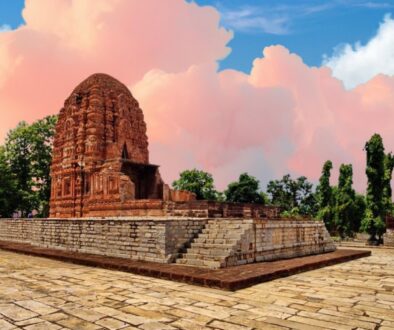Jaipur: The Pink City’s Timeless Charm and Royal Grandeur
Jaipur, the capital of Rajasthan, is a city where history, culture, and modernity blend seamlessly. Known as the Pink City due to the distinctive terracotta hue of its buildings, Jaipur is a vibrant destination that offers a glimpse into India’s royal past while embracing the energy of contemporary life. From majestic forts and opulent palaces to bustling markets and delectable cuisine, Jaipur is a city that captivates every traveler.
A Glimpse into Jaipur’s Rich History
Founded in 1727 by Maharaja Sawai Jai Singh II, Jaipur was one of the first planned cities in India. The city’s layout follows Vastu Shastra principles, ensuring harmony between architecture and nature. The uniform pink color, introduced in 1876 to welcome Prince Albert, has since become an iconic feature of Jaipur’s landscape.
Top Attractions in Jaipur
Jaipur is home to some of the most breathtaking architectural marvels and historical sites in India. Here are the must-visit places in the Pink City:
1. Amber Fort – A Majestic Hilltop Fortress
Perched on a hilltop, Amber Fort (or Amer Fort) is a stunning blend of Hindu and Mughal architecture. The fort’s intricate mirror work, vast courtyards, and scenic views of Maota Lake make it one of Jaipur’s most captivating landmarks. The light and sound show in the evening brings the fort’s history to life in a mesmerizing way.
2. City Palace – The Heart of Jaipur’s Royal Legacy
Located in the heart of Jaipur, City Palace is a grand complex of courtyards, gardens, and museums. It houses the Chandra Mahal and Mubarak Mahal, showcasing royal costumes, weapons, and artifacts. A section of the palace is still home to the Royal Family of Jaipur, making it a living piece of history.
3. Hawa Mahal – The Palace of Winds
Perhaps Jaipur’s most recognizable landmark, Hawa Mahal is an architectural masterpiece with 953 small windows (jharokhas). Built in 1799, this structure allowed royal women to observe street festivities without being seen, ensuring their privacy while enjoying the city’s vibrancy.
4. Jantar Mantar – An Astronomical Wonder
A UNESCO World Heritage Site, Jantar Mantar is an observatory built by Maharaja Sawai Jai Singh II. It houses the world’s largest stone sundial, along with other instruments designed to measure time and track celestial bodies.
5. Nahargarh Fort – A Viewpoint Like No Other
Overlooking Jaipur, Nahargarh Fort offers a panoramic view of the city. Whether you visit during the day or at sunset, the fort’s beauty and tranquility make it an ideal retreat from the city’s hustle and bustle.
6. Jaigarh Fort – The Guardian of Jaipur
Jaigarh Fort, known for housing Jaivana – the world’s largest cannon on wheels, was built to protect Amber Fort. Its robust structure and underground water reservoirs reflect Jaipur’s strategic military strength.
The Colorful Bazaars of Jaipur
Jaipur’s markets are a paradise for shopaholics. Here are some must-visit shopping destinations:
- Johari Bazaar: Famous for exquisite jewelry, gemstones, and silverware.
- Bapu Bazaar: Best place for Jaipur’s famous Mojari (leather footwear) and textiles.
- Tripolia Bazaar: A hub for brassware and lac bangles.
- Chandpole Bazaar: The go-to place for traditional handicrafts and marble sculptures.
Savor the Flavors of Jaipur
Rajasthani cuisine is a delightful experience, and Jaipur offers some of the best dishes to indulge in:
- Dal Baati Churma: A traditional Rajasthani dish consisting of baked wheat balls, lentils, and sweet crumbled wheat.
- Ghewar: A mouthwatering sweet dish, especially popular during festivals.
- Pyaaz Kachori: A spicy, deep-fried snack filled with onion and spices.
- Laal Maas: A fiery mutton curry infused with red chilies and robust flavors.
For an authentic culinary experience, visit famous eateries like Laxmi Mishthan Bhandar (LMB), Rawat Mishtan Bhandar, and Suvarna Mahal at Rambagh Palace.
Best Time to Visit Jaipur
The ideal time to visit Jaipur is between October and March, when the weather is pleasant for sightseeing and outdoor activities. Summers can be scorching, while the monsoon season brings brief relief with sporadic rainfall.
Festivals That Bring Jaipur to Life
Jaipur’s cultural richness shines through its vibrant festivals:
- Jaipur Literature Festival (January): The world’s largest free literary festival.
- Teej Festival (July-August): Celebrated with processions, traditional music, and dance.
- Gangaur Festival (March-April): Dedicated to Goddess Gauri, symbolizing marital bliss.
- Diwali (October-November): Jaipur dazzles with lights, making it an unforgettable experience.
How to Reach Jaipur
Jaipur is well-connected by air, rail, and road:
- By Air: Jaipur International Airport (JAI) connects the city to major domestic and international destinations.
- By Rail: Jaipur Junction Railway Station is a key hub in North India.
- By Road: Jaipur has excellent road connectivity with Delhi, Agra, and other major cities via NH48.
Conclusion: A City That Stays in Your Heart
Jaipur is more than just a travel destination; it’s an experience that leaves an everlasting impression. Whether you’re exploring grand palaces, indulging in royal cuisine, or shopping for vibrant handicrafts, the Pink City welcomes you with open arms.
So, pack your bags and get ready to immerse yourself in the royal charm, colorful streets, and cultural richness of Jaipur—a city where history meets modernity in the most enchanting way.
Want to explore more fascinating destinations? Stay tuned for more travel blogs!



